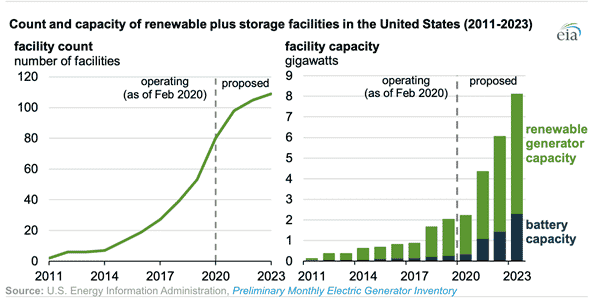Number of Renewable Projects Co-located With Storage Continue to Grow Across U.S: EIA

The number of solar and wind generation sites co-located with battery installations has grown to 53 in 2019, from 19 paired sites in 2016, according to a May 18 report from the U.S. Energy Information Administration. Another 56 such facilities will come online by the end of 2023 according to planned installations reported to the agency.
Pairing renewable energy installations with batteries is becoming common as the cost of energy storage continues to fall. The agency underscored the ability of batteries to serve multiple applications. The main benefit of battery-paired renewable facilities is the ability to store excess energy and redistribute when needed. This function reduces the need to curtail generation and facilitates energy deployment during periods of high demand. Frequency regulation, which helps maintain the grid’s electric frequency on a second-to-second basis, is the second-most common use for batteries co-located with renewables, according to the agency.
- More than 90 percent of the operating renewable plus energy storage, or hybrid, capacity is located in just nine states, with Texas representing 46 percent of the current total.
- Nearly 25 percent of total U.S. battery capacity is installed as part of a hybrid system, while a mere 1 percent of total wind capacity and 2 percent of solar capacity form a part of such a system.
- By the end of 2023, average renewable capacity at proposed U.S. facilities is expected to more than double from 34 megawatts to 75 megawatts, and average battery capacity is projected to grow from 5 megawatts to 36 megawatts.
EnerKnol Pulses like this one are powered by the EnerKnol Platform—the first comprehensive database for real-time energy policy tracking. Sign up for a free trial below for access to key regulatory data and deep industry insights across the energy spectrum.
ACCESS FREE TRIAL